| Article ID | Journal | Published Year | Pages | File Type |
|---|---|---|---|---|
| 673468 | Thermochimica Acta | 2013 | 8 Pages |
•Non-isothermal degradation kinetics for cured EA-based polymers studied.•Kinetic parameters for degradation of cured EA-based polymers determined.•Deconvolution successfully used to characterize complex degradation process.•Cured polymer of BTA/EA showed worse thermal stability than BPO/EA.•Degradation kinetics closely related to cross-linked network structures.
Non-isothermal degradation kinetics of cured polymer samples of barbituric acid (BTA)/bisphenol A diglycidyl ether diacrylate (EA) and benzoyl peroxide (BPO)/EA was investigated. The sample of BTA/EA exhibited an inferior thermal stability as compared to the BPO/EA counterpart (as the reference sample). The degradation kinetics for both cured polymer samples of BTA/EA and BPO/EA were determined by the model-fitting method with the aid of a deconvolution technique. For the sample of BTA/EA, the complex degradation process was described by the diffusion-controlled and reaction-controlled mechanisms in the first and second steps, respectively. For the sample of BPO/EA, the mechanism responsible for the first step of the degradation process was reaction-controlled. By contrast, the degradation process was described by the nucleation-controlled mechanism, followed by the multi-molecular decay law in the second step. Different degradation kinetics and mechanisms between cured polymer samples of BTA/EA and BPO/EA were attributed to their different crosslinked network structures.
